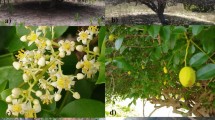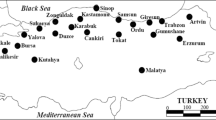Abstract
The genus Armeniaca Scop. is well known for its popular cultivated edible fruit trees such as Armeniaca vulgaris Lam. and ornamental flowers such as A. mume Sieb. Another species, A. cathayana Fu et al., one of six important dry fruits (kernel-using apricot), is cultivated for its edible seeds in North China. In the present study, DNA from 70 individuals of Armeniaca, including 38 of A. cathayana, 18 of A. vulgaris, 12 of A. sibirica, 1 of A. dasycarpa and 1 of A. mume, was extracted and analyzed using microsatellites and capillary electrophoresis. For 20 polymorphic loci selected, 339 alleles and 140.7 effective alleles were detected. The number of alleles per locus ranged from 8 to 28, with an average of 16.95 alleles per locus. The observed heterozygosity (Ho) and the expected heterozygosity (He) ranged from 0.427 to 0.971 and from 0.737 to 0.912, respectively. The polymorphism information content varied from 0.708 to 0.905, with an average of 0.827. Based on the genetic similarity among 70 individuals, a UPGMA was used to establish the phylogenetic relationships. The taxonomic positions among five species were clearly revealed, and A. cathayana was more closely related to A. vulgaris than to A. sibirica. The results will provide a scientific basis for research on the taxonomy, germplasm resources and breeding of Armeniaca, especially for A. cathayana.


Similar content being viewed by others
References
Bekele E, Shigeta M (2011) Phylogenetic relationships between Ensete and Musa species as revealed by the trnT trnF region of cpDNA. Genet Res Crop Evol 58(2):259–269
Bhargava A, Fuentes FF (2010) Mutational dynamics of microsatellites. Mol Biotechnol 44:250–266
Borsch T, Hilu KW, Quandt D, Wilde V, Neinhuis C, Barthlott W (2003) Noncoding plastidic trnT-trnF sequences reveal a well resolved phylogeny of basal angiosperms. J Evol Biol 16:558–576
Calonje M, Martín-Bravo S, Dobeš C, Gong W, Jordon-Thaden I, Kiefer C, Kiefer M, Paule J, Schmickl R, Koch MA (2009) Non-coding nuclear DNA markers in phylogenetic reconstruction. Plant Syst Evol 282:257–280
Castro P, Gil J, Cabrera A, Moreno R (2013) Assessment of genetic diversity and phylogenetic relationships in Asparagus species related to Asparagus officinalis. Genet Resour Crop Evol 60(4):1275–1288
Doyle JJ, Doyle JL (1987) A rapid DNA isolation procedure for small quantities of fresh leaf tissue. Phytoch Bull 19:11–15
Fu DL, Li BR, Fu JM, Li JH, Yang SB, Zhou DS, Liu MP (2010) A new species of Armeniaca scop. from China. Bull Bot Res 30(1):1–3 (In Chinese)
Fu DL, Liu MP, Fu JM, Tian M, Ma LY, He F, Liang C, Wei SZ (2011) Analysis of the taxonomical position of species Armeniaca cathayana using SSR molecular markers. J Cent South Univ For Technol 31(3):60–64 (In Chinese)
Han BM, Zhao MZ, Wang J, Yu HM (2012) Phylogenetic relationships among Fragaria germplasm by SSR markers. Act Hortic Sin 39(12):2352–2360 (In Chinese)
He TM (2006) The genetic diversity of germplasm of Prunus armeniaca and the origin of P. dasycarpa. [D] Shandong: Shandong Agricultural University 8–27 (In Chinese)
Koch MA, Dobes C, Mitchell-Olds T (2003) Multiple hybrid formation in natural populations: concerted evolution of the internal transcribed spacer of nuclear ribosomal DNA (ITS) in North American Arabis divaricarpa (Brassicaceae). Mol Biol Evol 20:338–350
Liang J, Pan YB, Li YR, Fang FX (2010) Assessment of genetic diversity in Saccharum using SSR markers and capillary electrophoresis. Guihaia 30(1):106–111 (In Chinese)
Liu X, Zhang L, Li G, Qin R, Liu H (2014) Application of nrDNA-ITS sequences in plant phylogeny and evolution. Bot Res 3:32–40 (In Chinese)
Lu LD, Gu CZ, Li CL (2003) Rosaceae. In: Wu ZY, Raven PH (eds) Flora of China 9:46–434. Science Press, Beijing, and Missouri Botanical Garden Press, St. Louis
Lü YM, Lü ZR, Gao SZ (1994) A study on the evolution relationship and classification of apricot via peroxidase isozyme zymograms analysis. Act Agric Bor-Sin 9(4):69–74 (In Chinese)
Qi JX, Hao YB, Zhu Y, Wu CL, Wang WX, Leng P (2011) Studies on germplasm of Juglans by EST-SSR markers. Act Hortic Sin 38(3):441–448 (In Chinese)
Selkoe KA, Toonen RJ (2006) Microsatellites for ecologists: a practical guide to using and evaluating microsatellite markers. Ecol Lett 9:615–629
Tang RH, He LQ, Zhuang WJ, Hang ZQ, Zhong RC, Gao GQ, Li Z (2007) Phylogenetic relationships in the genus Arachis based on SSR molecular marker profile. Chin J Oil Crop Sci 29(2):142–147 (In Chinese)
Thibodeau SN, Bren G, Schaid D (1993) Microsatellite instability in cancer of the proximal colon. Science 260:816–819
UPOV/INF/17/1 (2010) Guideline for DNA-profiling: molecular marker selection and database construction (BMT Guideline). Geneva
Volkov RA, Komarova NY, Hemleben V (2007) Ribosomal DNA in plant hybrids: inheritance, rearrangements, expression. Syst Biodivers 5:261–276
Wang YZ, Sun HY, Yang L, Zhang KC, Lin K (2006) Study on the phylogenetic relationship among genus Armeniaca based on RAPD markers. Chin Agric Sci Bull 22(5):53–56 (In Chinese)
Wissemann V (2000) Molekulargenetische und morphologisch-anatomische Untersuchungen zur evolution und Genomzusammensetzung von Wildrosen der Sektion Caninae (DC.). Ser Bot Jahrb Syst 122:347–429
Wu YX, Daud MK, Chen L, Zhu SJ (2007) Phylogenetic diversity and relationship among Gossypium germplasm using SSRs markers. Plant Syst Evol 268:199–208
Yü TT, Lu LT, Ku TC, Chen SX (1986) Rosaceae. In: Yü TT (ed) Flora Reipublicae Popularis Sinicae 38:24–33 Science Press, Beijing (In Chinese)
Zhan QW, Zhang TZ, Wang BH, Li JQ (2008) Diversity comparison and phylogenetic relationships of S. bicolor and S. sudanense as revealed by SSR markers. Plant Sci 174(1):9–16
Zhang JY, Wu XZ (2009) A new species of the genus Armeniaca (Rosaceae). Bull Bot Res 29(1):1–2 (In Chinese)
Zhang LY, Ravel C, Bernard M, Balfourier F, Leroy P, Feuillet C, Sourdille P (2006) Transferable bread wheat EST-SSRs can be useful for phylogenetic studies among the Triticeae species. Theor Appl Genet 113(3):407–418
Zhu S, Wang F, Shen W, Jiang D, Hong Q, Zhao X (2015) Genetic diversity of Poncirus and phylogenetic relationships with its relatives revealed by SSR and SNP/InDel markers. Acta Physiol Plant 37:141
Zhuge Q, Ding YL, Xu Ch, Zou HY, Huang MR, Wang MX (2005) A preliminary analysis of phylogenetic relationships of Arundinaria and related genera based on nucleotide sequences of nrDNA (ITS region) and cpDNA (trnL-F intergenic spacer). J For Res 16(1):5–8
Acknowledgments
Genotyping was done by Beijing Boyoushun Biotechnology Limited Corporation.
Author information
Authors and Affiliations
Corresponding authors
Additional information
Project funding: This work was financially supported by 948 Project (No.2011-4-37) and Standardization Project (No.2013-LY-082) of The State Forestry Administration of China.
The online version is available at http://www.springerlink.com
Corresponding editor: Hu Yanbo
Rights and permissions
About this article
Cite this article
Fu, D., Ma, L., Qin, Y. et al. Phylogenetic relationships among five species of Armeniaca Scop. (Rosaceae) using microsatellites (SSRs) and capillary electrophoresis. J. For. Res. 27, 1077–1083 (2016). https://doi.org/10.1007/s11676-016-0245-y
Received:
Accepted:
Published:
Issue Date:
DOI: https://doi.org/10.1007/s11676-016-0245-y




